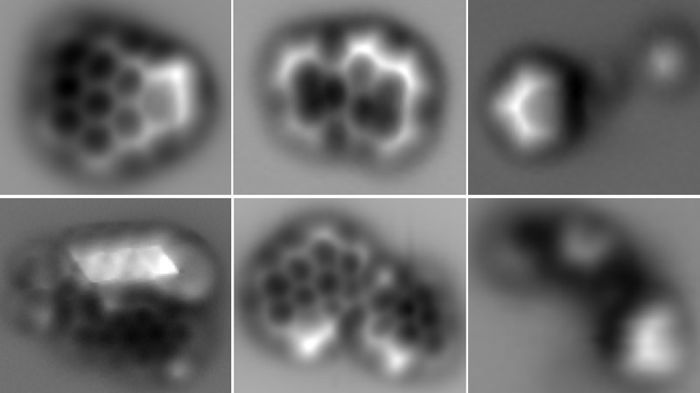
High-resolution imaging has revealed the structural make-up of soot particles. Credit: F. Schulz et al./PROCI and Nature international journal of science highlights
In this 13-part series of monthly articles, The Combustion Institute recognizes the 2019 Distinguished Papers selected from among the scientific papers presented during the 37th International Symposium on Combustion. Congratulations to Fabian Schulz, Mario Commodo, Katharina Kaiser, Gianluigi De Falco, Patrizia Minutolo, Gerhard Meyer, Andrea D’Anna, and Leo Gross for winning the DPA in the Soot, Nanomaterials, and Large Molecules colloquium.
Their authoritative paper, Insights into incipient soot formation by atomic force microscopy, has significantly enhanced the understanding of the soot formation process and the appearance of soot precursors. Their work showed, for the first time, by high-resolution atomic force microscopy and scanning tunneling microscopy, the molecular constituents of the just nucleated soot particles. These measurements provide important and unique information on the types and chemical characteristics of the aromatic building blocks forming the just-incepted particles. The results constitute an important advancement in understanding the chemistry of soot particles at their early stage of formation and can serve to guide and aid future detailed soot models.
The increased information about the appearance of soot precursors can help scientists and engineers to understand and potentially prevent their formation. The researchers hope the knowledge of the chemical constituents of soot particles will improve the understanding of the effects of these nanoparticles on the human body and on climate change and promote a new generation of less-polluting combustion technologies.
The collaboration between the Italian and Swiss research teams began in early 2017. The work supporting this paper was performed in two laboratories, one at the University of Naples Federico II in Italy and the Italian Institute for Research on Combustion of the CNR, and the other at IBM Research–Zurich in Switzerland. In addition to being presented at the 37th International Symposium on Combustion, this work was highlighted in the journal, Nature, as “First portrait of a soot molecule.” The teams continuing research has led to the publication of “On the early stages of soot formation: Molecular structure elucidation by high-resolution atomic force microscopy” in the July 2019 issue of Combustion and Flame.
Over 1,600 papers were submitted to the 37th Symposium in 13 combustion science colloquia. Those papers were categorized by teams of colloquium coordinators and co-chairs, and then distributed to approximately 1,000 scientific reviewers. One paper in each discipline was awarded the recognition of Distinguished Paper.
The 13 Distinguished Papers undergo committee review for consideration to receive the Silver Combustion Medal that will be awarded during the 38th International Symposium on Combustion in Adelaide, Australia. A paper selected for this honor exemplifies quality, achievement, and significance to advance a field of combustion science. Distinguished papers are selected biennially from among the scientific papers presented during the International Symposium on Combustion and accepted for publication in the Proceedings of The Combustion Institute.
